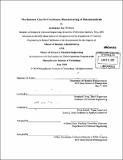The business case for continuous manufacturing of pharmaceuticals
Author(s)
Wilburn, Kristopher Ray
DownloadFull printable version (3.739Mb)
Other Contributors
Leaders for Global Operations Program.
Advisor
Bernhardt Trout and Ernst Berndt.
Terms of use
Metadata
Show full item recordAbstract
Manufacturing in the pharmaceutical industry is presently characterized as a batch production system, which has existed in its current form for decades. This structure is the result of historical regulatory policy as well as the conservative nature of the industry. Recent clarification by US and European regulatory bodies has opened the possibility to new approaches to the manufacturing process. This combined with changes in the market for the pharmaceutical industry has accelerated the rate at which new manufacturing technologies are explored. Continuous manufacturing is a paradigm shift in the pharmaceutical industry manufacturing structure, encompassing several new technologies and systems. The business impact of continuous manufacturing has not been well defined. This assessment aims to compare a continuous manufacturing process to a batch manufacturing process for a particular Novartis product. The product has an established batch production process. Cost estimates and the continuous process cost is estimated using a four-step process: defining the process flow, performing the material balance, estimating the capital costs, and estimating the operating costs. This analysis shows that for the particular Novartis product considered, a continuous process is an improvement over the batch process in four performance characteristics: capital investment, operating cost, throughput time, and working capital requirement.
Description
Thesis (M.B.A.)--Massachusetts Institute of Technology, Sloan School of Management; and, (S.M.)--Massachusetts Institute of Technology, Dept. of Chemical Engineering; in conjunction with the Leaders for Global Operations Program at MIT, 2010. Cataloged from PDF version of thesis. Includes bibliographical references (p. 52-53).
Date issued
2010Department
Leaders for Global Operations Program at MIT; Massachusetts Institute of Technology. Department of Chemical Engineering; Sloan School of ManagementPublisher
Massachusetts Institute of Technology
Keywords
Sloan School of Management., Chemical Engineering., Leaders for Global Operations Program.